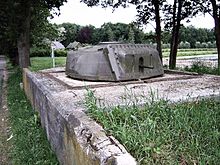IJssel line
The IJssel Line (German Issel-line ) was in the 1950s and 1960s, the Dutch part of the defense line of the Cold War, the NATO for Western Europe. It consisted of bunkers for anti-aircraft and four-flame machine guns, command and hospital bunkers as well as many concrete-encased armored turrets and Sherman bunkers that left the towers exposed. These elements were placed along the IJssel.
history
In the 16th and 17th centuries, and at the time of the German invasion of 1940, fortified defense lines, also known as the IJssel line, were laid out along the IJssel.
Movable floating dams were built on the Lower Rhine and Waal rivers . By diverting the water flow from Germany to the IJssel River, the entire 127 km long IJssel Valley could be flooded to create a line of defense against an expected Soviet invasion. The extensive floods of the IJssel floodplains and the surrounding areas were intended as an essential barrier between Nijmegen and Kampen. In order to ensure a sufficient amount of water for the area north of Deventer, a third movable floating dam was added in Olst. The flood was to be released from the IJssel river by 15 water intake facilities and 750 other water regulation structures. The flood would then flood large areas in the winter dykes. Five motorized infantry divisions of the Dutch field army were to be set up behind the defense line. The defense line at IJssel was intended to slow down a Soviet offensive and bring Allied support to the Netherlands. The IJssel Line would have been a northern extension of NATO's main defense along the Rhine and would have prevented an almost immediate occupation of the Randstad Netherlands, as would have been the case in the original version of the NATO plan, and sees a southern defense in this Area along the Lower Rhine or Waal and leave the large Dutch cities and ports to the enemy. The new plan was developed by Captain Joop Haex , who later became the Dutch Secretary of State for Defense. The line was abolished after 1968 when the NATO strategy of forward defense along the inner-German border was adopted.
The IJssel-Linien Foundation was established in 2003 as a voluntary foundation in order to preserve the buildings and structures as historical monuments.
Individual evidence
- ↑ Sherman tank . IJssellinie.nl. Archived from the original on March 4, 2016. Info: The archive link was inserted automatically and has not yet been checked. Please check the original and archive link according to the instructions and then remove this notice. Retrieved March 17, 2012.
- ^ IJssel Line Foundation . IJssellinie.nl. December 22nd, 2003. Archived from the original on April 26th, 2012. Info: The archive link was inserted automatically and has not yet been checked. Please check the original and archive link according to the instructions and then remove this notice. Retrieved March 17, 2012.

